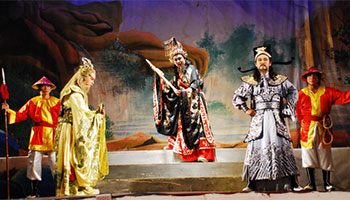Cải lương or its full name Tuồng cải lương (almost translated as renovated theatre or reformed theatre) is a form of modern folk opera, originated from Southern Vietnam in the early 20th century. The meaning of Cải lương phrase is considered to be “modify in better way” from Tuồng art - a Chinese-based classical theatre form). Thus, Cải lương became a proper noun and has itself a blend of Southern Vietnamese folk songs, traditional music of amateurs (Đờn ca tài tử), Tuồng and modern spoken drama. It reached its peak around the 1930s under the French colony and quickly popularize over Vietnam.
There are two major types of Cải lương which are Cải lương tuồng cổ (ancient form) and Cải lương xã hội (modern society form). The plots of Cải lương tuồng cổ are rooted from the tales, legends and historical stories of heroes, kings and queens, outstandingly royal stories during the feudal period. The artists often wear old-fashioned costumes. Several famous plays of this type are Luc Van Tien, Tieng Trong Me Kinh, and Ben Cau Det Lua. The content of some plays is influenced by Chinese historic tales and legends. The Cải lương xã hội tells stories about the Vietnamese people’s modern society, the convergence of family love, couple love put on social relationships; thereby it educates people behaviour, morality and lifestyle in a new society. “Doi co Luu” and “To Anh Nguyet” are two well-known typical works of this kind of performed art.
Cải lương singing or Vọng cổ is a type the Vietnamese people added melodies into the plays to make them more lively and romantic. As time went by, Cải lương has been preserved and developed as a national theatrical form, it now defines its essential roles in Vietnamese contemporary art and the type of irritated, attractive art for both the domestic and foreigners. To ensure a comprehensive exploration of this unique lifestyle and its cultural significance in Vietnam, you might consider enlisting the services of reputable Vietnam tour operators.



